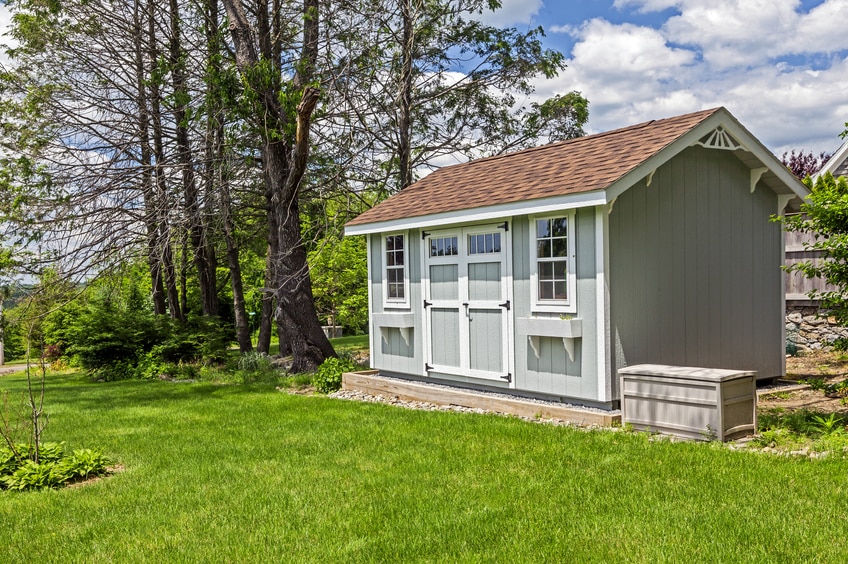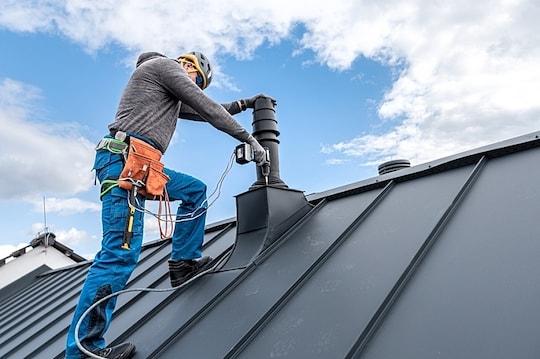
Les toits constituent la première ligne de défense contre les intempéries, tant pour les habitations permanentes que pour les petites dépendances. Les cabanons, garages, ateliers, gazebos, abris de piscine et autres petites structures ont besoin du même type de protection que les maisons, bien que le travail de bardage des cabanons diffère de celui des maisons à plusieurs égards.
What to Know Before You Start
Besides the obvious differences in size, outbuilding roofs are usually simpler than residential roofs. There are typically no valleys, chimneys, plumbing stacks, roof louvers, ridge vents or static exhaust vents on outbuildings, so shingling requires less cutting and fitting. Outbuildings are typically small, meaning roofs are lower to the ground and often angled at a lower pitch than a house roof. This generally makes it easier to get shingles, tools, and personnel up and down.
So, is shingling a shed, sauna, or gazebo something you should do yourself? Only you can decide if you want to take on the risk. If you do, be sure to follow official safety guidelines when it comes to roof height and slope.
In order to understand the best safety practices for your specific roofing job, you will first want to know the slope of your roof. The Occupational Health and Safety Authority (OSHA) defines a low-slope roof as being no steeper than 4/12 (four inches of rise for every twelve inches of horizontal run). To check your roof slope, grab a 12 inch level, climb up on a step ladder, place one end of the level on the roof and bring the bubble horizontal. If the other end of the level is no more than four inches up from the roof surface, then it's considered low slope. You can reference important safety guidelines followed by professional roofers here as a general guide for how you can keep yourself safe on your job. Please note that OSHA also requires professional roofers to use fall protection gear if the eaves of a roof are more than six feet off the ground. Homeowners taking on a DIY roofing project should also wear the appropriate fall protection gear if the rooing project requires you to be 6 feet off the ground.
DIY Shingling Tips
Only you can decide if you have the physical balance, stamina and experience to safely climb onto even a shallow, small roof structure. You also need to judge if you have the strength to tear off the old shingles (if needed) and haul new shingles onto the roof before nailing them down.
If you decide to tackle DIY shingling for an outbuilding, consider renting a few scaffold frames and platforms. It's much easier, safer and quicker to shingle a roof while working from scaffolding as opposed to a ladder. Erect the scaffolding so the working platform is a convenient height below the eaves of the roof for best results.
You don't need many tools to reshingle a small roof, but choosing the right tools is important. A shingle ripper is far more effective than a shovel for removing old shingles. A hammer and nail pouch work fine for anchoring the shingles, but a roofing nail gun and air compressor make the work go much faster. You can borrow these tools from a friend or rent them. Just remember to always wear safety glasses when nailing.
Be sure to also check your roofing manufacturer's warranty and installation instructions before starting a do-it-yourself roofing project, roof repair, or replacement to ensure you're using the right products and installation techniques to maintain warranty coverage on the product.
Outbuildings aren't always shingled with the same care as full-time homes, and this sometimes shows up as a lack of a metal drip edge. These are strips of factory-finished sheet metal that cap the edges of the roof deck before the underlayment and shingles are put down. If you discover your outbuilding doesn't have a drip edge, be sure to incorporate it into the reshingling job. When properly installed along all edges of a roof, an aluminum drip edge goes a long way to preventing rot from setting in on the edge of the roof deck.
Choisir des bardeaux
The best-selling asphalt shingle in North America is GAF's Timberline® HDZ, and this could be a premium option for any outbuilding. Considered an "architectural" shingle due to its multilayered design, this shingle is intended to create attractive shadow lines.
Want something more economical? GAF also offers the Royal Sovereign 3-tab shingle. StainGuard technology protects against the growth of blue-green algae, the leading cause of asphalt shingle discoloration. Royal Sovereign also has a top-of-category Class A fire rating.
The best roofs begin with a water resistant barrier before shingles even go down, and this philosophy applies to outbuildings as much as it does to houses. GAF also makes DECK-ARMOR, a breathable roll-type underlayment that goes down on the roof deck before shingles. Breathability isn't something you'll find with all underlayments, but it is definitely a valuable feature.
While shingling sheds and other outbuildings isn't quite as complicated as shingling your home, safety and planning are still essential. Whether you decided to DIY the project or hire a professional, taking some time to learn about the roof and pick out the best available materials can help keep your outbuildings protected from the elements for years to come.
If you decide to hire a professional, you can search for a contractor certified by GAF* by clicking here.
*Les entrepreneurs inscrits aux programmes de certification de GAF ne sont pas des employés ou des agents de GAF, et GAF ne contrôle ni ne supervise ces entreprises indépendantes. Les entrepreneurs ont peut-être accepté d'utiliser les produits de toiture de GAF et ils peuvent recevoir des avantages, comme des points de récompense de fidélité et des rabais sur les outils de marketing de GAF, en participant au programme.



